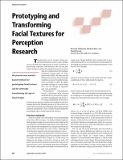Files in this item
Prototyping and transforming facial textures for perception research
Item metadata
| dc.contributor.author | Tiddeman, Bernard Paul | |
| dc.contributor.author | Perrett, David Ian | |
| dc.contributor.author | Burt, D.M. | |
| dc.date.accessioned | 2010-12-02T16:42:46Z | |
| dc.date.available | 2010-12-02T16:42:46Z | |
| dc.date.issued | 2001-09 | |
| dc.identifier | 161327 | |
| dc.identifier | 9e2b4bec-71b3-4c24-9ddb-6bf3e8179d0f | |
| dc.identifier | 000170643300008 | |
| dc.identifier | 0035449880 | |
| dc.identifier.citation | Tiddeman , B P , Perrett , D I & Burt , D M 2001 , ' Prototyping and transforming facial textures for perception research ' , IEEE Computer Graphics and Applications , vol. 21 , no. 5 , pp. 42-50 . https://doi.org/10.1109/38.946630 | en |
| dc.identifier.issn | 0272-1716 | |
| dc.identifier.other | ORCID: /0000-0002-6025-0939/work/64360989 | |
| dc.identifier.uri | https://hdl.handle.net/10023/1596 | |
| dc.description.abstract | Transforming facial images along perceived dimensions (such as age, gender, race, or health) has application in areas as diverse as psychology, medicine, and forensics. We can use prototype images to define the salient features of a particular face classification (for example, European female adult or East-Asian male child). We then use the differences between two prototypes to define an axis of transformation, such as younger to older. By applying these changes to a given input face, we can change its apparent age, race, or gender. Psychological investigations reveal a limitation with existing methods that's particularly apparent when changing the age of faces. We relate the problem to the loss of facial textures (such as stubble and wrinkles) in the prototypes due to the blending process. We review the existing face prototyping and transformation methods and present a new, wavelet-based method for prototyping and transforming facial textures. | |
| dc.format.extent | 9 | |
| dc.format.extent | 1241154 | |
| dc.language.iso | eng | |
| dc.relation.ispartof | IEEE Computer Graphics and Applications | en |
| dc.subject | Faces | en |
| dc.subject | Shape | en |
| dc.subject | Color | en |
| dc.subject | QA76 Computer software | en |
| dc.subject.lcc | QA76 | en |
| dc.title | Prototyping and transforming facial textures for perception research | en |
| dc.type | Journal article | en |
| dc.contributor.institution | University of St Andrews. School of Computer Science | en |
| dc.contributor.institution | University of St Andrews. School of Psychology and Neuroscience | en |
| dc.identifier.doi | 10.1109/38.946630 | |
| dc.description.status | Peer reviewed | en |
| dc.identifier.url | http://www.scopus.com/inward/record.url?scp=0035449880&partnerID=8YFLogxK | en |
This item appears in the following Collection(s)
Items in the St Andrews Research Repository are protected by copyright, with all rights reserved, unless otherwise indicated.

